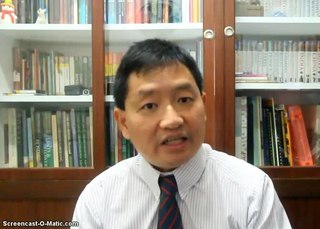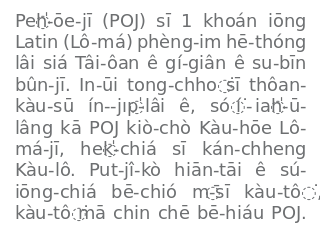English usually refers to:

Taiwanwe, also known as Taigi/Taigu, Hoklo called by Hakka people, is a variety of the Hoklo language spoken natively by about 70%+ of the population of Taiwan. It is spoken by the Taiwanese people, who descended from immigrants from southern Fujian during the Beng dynasty. The POJ romanization is a orthography for Taiwanwe.

Ketchup or catsup is a type of table condiment with a sweet and tangy flavor. The unmodified term ("ketchup") now typically refers to tomato ketchup, although original recipes used egg whites, mushrooms, oysters, grapes, mussels, or walnuts, among other ingredients.

Southern Min, Minnan or Banlam, is a group of linguistically similar and historically related Sinitic languages that form a branch of Min Chinese spoken in Fujian, most of Taiwan, Eastern Guangdong, Hainan, and Southern Zhejiang. The Minnan dialects are also spoken by descendants of emigrants from these areas in diaspora, most notably the Philippines, Indonesia, Malaysia, Singapore, San Francisco, Los Angeles and New York City. It is the most populous branch of Min Chinese, spoken by an estimated 48 million people in ca. 2017–2018.

Postal romanization was a system of transliterating Chinese place names developed by postal authorities in the late 19th and early 20th centuries. For many cities, the corresponding postal romanization was the most common English-language form of the city's name from the 1890s until the 1980s, when postal romanization was replaced by pinyin.

Penang Hokkien is a local variant of Hokkien spoken in Penang, Malaysia. It is spoken as a mother tongue by 63.9% of Penang's Chinese community, and also by some Penangite Indians and Penangite Malays.

Amoy Gardens is a private housing estate in the Jordan Valley area of Kowloon, Hong Kong completed from 1981 to 1987. It was the most seriously affected location during the 2003 outbreak of Severe Acute Respiratory Syndrome (SARS), with over 300 people infected there.

Amoy Food Limited is a manufacturer of cooking sauces and condiments in Hong Kong. Its products, which now include foodstuffs such as frozen foods and instant foods for heating in a microwave oven, are sold around the world. It was acquired in 2018 by CITIC Capital, a subsidiary of the CITIC Group.

John Van Nest Talmage, was a Protestant Christian missionary to Amoy, Fujian, China. He was sent by the Reformed Church in America from 1847 to 1890.

Pe̍h-ōe-jī, also sometimes known as the Church Romanization, is an orthography used to write variants of Southern Min Chinese, particularly Taiwanese Hokkien and Amoy Hokkien.

Philippine Hokkien is a dialect of the Hokkien language of the Southern Min branch, primarily spoken vernacularly by Chinese Filipinos in the Philippines, where it serves as the local Chinese lingua franca, primarily spoken as an oral language, within the overseas Chinese community in the Philippines and acts as the heritage language of a majority of Chinese Filipinos. The use of Hokkien in the Philippines is influenced by Philippine Spanish, Filipino (Tagalog) and Philippine English.

The Amoy dialect or Xiamen dialect, also known as Amoynese, Amoy Hokkien, Xiamenese or Xiamen Hokkien, is a dialect of Hokkien spoken in the city of Xiamen and its surrounding metropolitan area, in the southern part of Fujian province. Currently, it is one of the most widely researched and studied varieties of Southern Min. It has historically come to be one of the more standardized varieties.
Singaporean Hokkien is a local variety of the Hokkien language spoken natively in Singapore. In Chinese academic circles, this dialect is known as Singaporean Ban-lam Gu. It bears similarities with the Amoy spoken in Amoy, now better known as Xiamen, as well as Taiwanese Hokkien which is spoken in Taiwan.

Carstairs Douglas was a Scottish missionary, remembered chiefly for his writings concerning the Southern Min language of Fujian, in particular his Chinese–English Dictionary of the Vernacular or Spoken Language of Amoy.

Hokkien is a Southern Min language originating from the Minnan region in the south-eastern part of Fujian Province in Southeastern Mainland China and spoken widely there. It is also spoken widely in Taiwan ; by the Chinese diaspora in Malaysia, Singapore, Indonesia, the Philippines and other parts of Southeast Asia; and by other overseas Chinese beyond Asia and all over the world. The Hokkien 'dialects' are not all mutually intelligible, but they are held together by ethnolinguistic identity. Taiwanese Hokkien is, however, mutually intelligible with the 2 to 3 million speakers of the Amoy (Xiamen) and Singaporean dialects, save for a few loanwords.

The Quanzhou dialects, also rendered Chin-chew or Choanchew, are a collection of Hokkien dialects spoken in southern Fujian, in the area centered on the city of Quanzhou. Due to migration, various Quanzhou dialects are spoken outside of Quanzhou, notably in Taiwan and many Southeast Asian countries, including Singapore, Malaysia and the Philippines.

The Zhangzhou dialects, also rendered Changchew, Chiangchew or Changchow, are a collection of Hokkien dialects spoken in southern Fujian province, centered on the city of Zhangzhou. The Zhangzhou dialect proper is the source of some place names in English, including Amoy, and Quemoy.

Elihu Doty was an American missionary to China. He was responsible for the first textbook of Southern Min in English. Along with John Van Nest Talmage he is credited with the invention of Pe̍h-ōe-jī, the most common orthography used to write Southern Min, although some doubt remains as to the exact origins of this system.

Southern Malaysian Hokkien is a local variant of the Min Nan Chinese variety spoken in Central and Southern Peninsular Malaysia. Due to geographical proximity, it is heavily influenced by Singaporean Hokkien.














